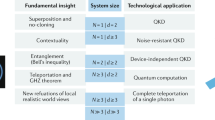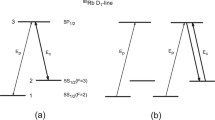Abstract
A recent paper (Chuan Wang in Phys Rev A 86:012323, 2012) discussed an entanglement concentration protocol (ECP) for partially entangled electrons using a quantum dot and microcavity coupled system. In his paper, each two-electron spin system in a partially entangled state can be concentrated with the assistance of an ancillary quantum dot and a single photon. In this paper, we will present an efficient ECP for such entangled electrons with the help of only one single photon. Compared with the protocol of Wang, the most significant advantage is that during the whole ECP, the single photon only needs to pass through one microcavity which will increase the total success probability if the cavity is imperfect. The whole protocol can be repeated to get a higher success probability. With the feasible technology, this protocol may be useful in current long-distance quantum communications.
Similar content being viewed by others
References
Nielsen M.A., Chuang I.L.: Quantum Computation and Quantum Information. Cambridge University Press, Cambridge (2000)
Gisin N., Ribordy G., Tittel W., Zbinden H.: Quantum cryptography. Rev. Mod. Phys. 74, 145 (2002)
Ekert A.K.: Quantum cryptography based on Bells theorem. Phys. Rev. Lett. 67, 661 (1991)
Bennett C.H., Brassard G., Crepeau C., Jozsa R., Peres A., Wootters W.K.: Teleporting an unknown quantum state via dual classical and Einstein-Podolsky-Rosen channels. Phys. Rev. Lett. 70, 1895 (1993)
Hillery M., Bužek V., Berthiaume A.: Quantum secret sharing. Phys. Rev. A 59, 1829 (1999)
Karlsson A., Koashi M., Imoto N.: Quantum entanglement for secret sharing and secret splitting. Phys. Rev. A 59, 162 (1999)
Xiao L., Long G.L., Deng F.G., Pan J.W.: Efficient multiparty quantum-secret-sharing schemes. Phys. Rev. A 69, 052307 (2004)
Long G.L., Liu X.S.: Theoretically efficient high-capacity quantum-key-distribution scheme. Phys. Rev. A 65, 032302 (2002)
Deng F.G., Long G.L., Liu X.S.: Two-step quantum direct communication protocol using the Einstein-Podolsky-Rosen pair block. Phys. Rev. A 68, 042317 (2003)
Wang C., Deng F.G., Li Y.S., Liu X.S., Long G. L.: Quantum secure direct communication with high-dimension quantum superdense coding. Phys. Rev. A 71, 044305 (2005)
Bennett C.H., Wiesner S.J.: Communication via one- and two-particle operators on Einstein-Podolsky-Rosen states. Phys. Rev. Lett. 69, 2881 (1992)
Bennett C.H., Bernstein H.J., Popescu S., Schumacher B.: Concentrating partial entanglement by local operations. Phys. Rev. A 53, 2046 (1996)
Bose S., Vedral V., Knight P.L.: Purification via entanglement swapping and conserved entanglement. Phys. Rev. A 60, 194 (1999)
Shi B.S., Jiang Y.K., Guo G.C.: Optimal entanglement purification via entanglement swapping. Phys. Rev. A 62, 054301 (2000)
Zhao Z., Pan J.W., Zhan M.S.: Practical scheme for entanglement concentration. Phys. Rev. A 64, 014301 (2001)
Yamamoto T., Koashi M., Imoto N.: Concentration and purification scheme for two partially entangled photon pairs. Phys. Rev. A 64, 012304 (2001)
Sheng Y.B., Deng F.G., Zhou H.Y.: Nonlocal entanglement concentration scheme for partially entangled multipartite systems with nonlinear optics. Phys. Rev. A 77, 062325 (2008)
Sheng Y.B., Deng F.G., Zhou H.Y.: Single-photon entanglement concentration for long distance quantum communication. Quant. Inf. Comput. 10, 272 (2010)
Sheng Y.B., Zhou L., Zhao S.M., Zheng B.Y.: Efficient single-photon-assisted entanglement concentration for partially entangled photon pairs. Phys. Rev. A 85, 012307 (2012)
Sheng Y.B., Zhou L., Zhao S.M.: Efficient two-step entanglement concentration for arbitrary W states. Phys. Rev. A 85, 044305 (2012)
Wang C., Zhang Y., Jin G.S.: Entanglement purification and concentration of electron-spin entangled states using quantum-dot spins in optical microcavities. Phys. Rev. A 84, 032307 (2011)
Wang C.: Efficient entanglement concentration for partially entangled electrons using a quantum-dot and microcavity coupled system. Phys. Rev. A 86, 012323 (2012)
Deng F.G.: Optimal nonlocal multipartite entanglement concentration based on projection measurements. Phys. Rev. A 85, 022311 (2012)
Wang H.F., Sun L.L., Zhang S., Yeon K.H.: Scheme for entanglement concentration of unkonwn partially entangled three-atom W states in cavity QED. Quantum Inf. Process. 11, 431 (2012)
Beenakker C.W.J., Divincenzo D.P., Emary C., Kindermann M.: Charge detection enables free-electron quantum computation. Phys. Rev. Lett. 93, 020501 (2004)
Waks E., Vuckovic J.: Dipole induced transparency in drop-filter cavity-waveguide systems. Phys. Rev. Lett. 96, 153601 (2006)
Bonato C., Haupt F., Oemrawsingh S.S.R., Gudat J., Ding D., van Exter M.P., Bouwmeester D.: CNOT and Bell-state analysis in the weak-coupling cavity QED regime. Phys. Rev. Lett. 104, 160503 (2010)
Wang T.J., Song S.Y., Long G.L.: Quantum repeater based on spatial entanglement of photons and quantum-dot spins in optical microcavities. Phys. Rev. A 85, 062311 (2012)
Hu C.Y., Munro W. J., Rarity J.G.: Deterministic photon entangler using a charged quantum dot inside a microcavity. Phys. Rev. B 78, 125318 (2008)
Hu C.Y., Munro W.J., ÓBrien J.L., Rarity J.G.: Proposed entanglement beam splitter using a quantum-dot spin in a double-sided optical microcavity. Phys. Rev. B 80, 205326 (2009)
Hu C.Y., Young A., ÓBrien J.L., Munro W.J., Rarity J.G.: Giant optical Faraday rotation induced by a single-electron spin in a quantum dot: applications to entangling remote spins via a single photon. Phys. Rev. B 78, 085307 (2008)
Hu C.Y., Rarity J.G.: Loss-resistant state teleportation and entanglement swapping using a quantum-dot spin in an optical microcavity. Phys. Rev. B 83, 115303 (2011)
Xu X., Yao W., Sun B., Steel D.G., Bracker A.S., Gammon D., Sham L.J.: A Jurassic ceratosaur from China helps clarify avian digital homologies. Nature(London) 459, 940 (2009)
Wang, C., Zhang, R., Zhang, Y., Ma, H.Q: Multipartite electronic entanglement purification using quantum-dot and microcavity system. Quantum Inf. Process.(2012). doi:10.1007/s11128-012-0397-4
Li, T., Ren, B.C., Wei, H.R., Hua, M., Deng, F.G.: High-efficiency multipartite entanglement purification of electron-spin states with charge detection. Quantum Inf. Process.(2012). doi:10.10007/s11128-012-0427-2
Reithmaier J. P., LöfflerG. Sek A., Hofmann C., Kuhn S., Eitzenstein S. R., Keldysh L. V., Kulakovskii V. D., Reinecke T.L., Forchel A.: Strong coupling in a single quantum dot-semiconductor microcavity system. Nature (London) 432, 197 (2004)
Yoshie T., Scherer A., Hendrickson J., Khitrova G., Gibbs H. M., Rupper G., Ell C., Shchekin O. B., Deppe D.G.: Vacuum Rabi splitting with a single quantum dot in a photonic crystal nanocavity. Nature (London) 432, 200 (2004)
Peter E., Senellart P., Martrou D., Lemaître A., Hours J., GérardJ. M., Bloch J.: Exciton-photon strong-coupling regime for a single quantum dot eEmbedded in a microcavity. Phys. Rev. Lett. 95, 067401 (2005)
Author information
Authors and Affiliations
Corresponding author
Rights and permissions
About this article
Cite this article
Sheng, YB., Zhou, L., Wang, L. et al. Efficient entanglement concentration for quantum dot and optical microcavities systems. Quantum Inf Process 12, 1885–1895 (2013). https://doi.org/10.1007/s11128-012-0502-8
Received:
Accepted:
Published:
Issue Date:
DOI: https://doi.org/10.1007/s11128-012-0502-8




